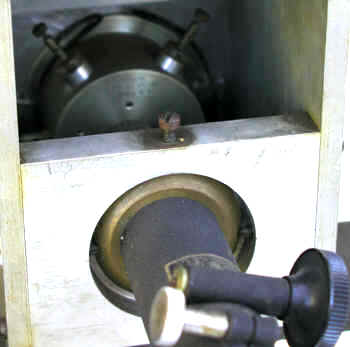Ionization Chamber of Gino Failla for Beta Measurements

This counting system was built by Gioacchino Failla (ca. 1945-1950) at Columbia University in New York to quantify beta sources.
It consists of a 5.5" diameter spherical chamber, the collecting electrode of which is connected to the fiber of a Lindemann-Ryerson electrometer. When viewed through the horizontally mounted microscope (projecting towards the right in the photograph), the fiber is seen superimposed on a scale.
To perform a measurement, the chamber is lowered down onto the sample, and the time it takes the fiber to move a specific number of divisions across the scale is recorded. This time is then related to the sample activity via a calibration.
Dr. S. Feitelberg of Mount Sinai Hospital, who knew Failla through two mutual acquaintances, Edith Quimby and Carl Braestrup, conveyed information about this design to H. Seliger and A. Schwebel at the National Bureau of Standards. The almost perfect duplicate they created was used to calibrate the NBS secondary beta standards. Learn more about the NBS unit.

The close-up to the left shows the base and focusing knobs of the microscope (in the lower half of the photo) and the top half of the Lindemann-Ryerson electrometer (in the upper portion of the photo).
